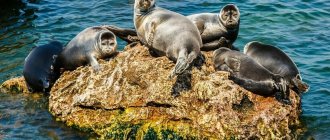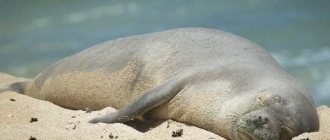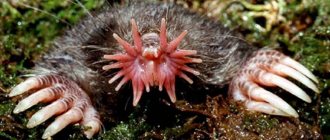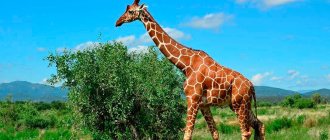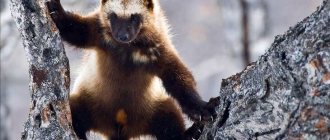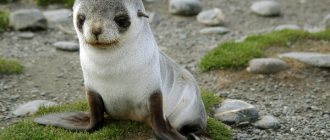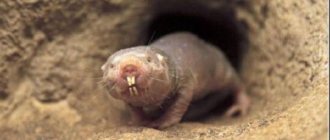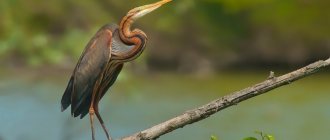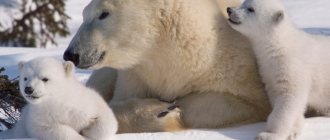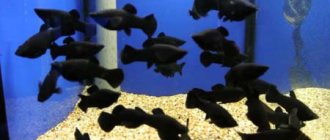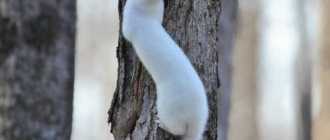The Baikal seal, or Baikal seal (lat. Pusa sibirica GmeL) is the only mammal that lives in Baikal. According to the classification, the Baikal seal belongs to the family of true seals (Phocidae), the genus Pusa. Researchers believe that the Baikal seal descended from a common ancestor with the northern ringed seal. Moreover, the ancestral forms of these two species are later than the Caspian seal. 1
Taxon rank. The Baikal seal (Phoca sibirica) belongs to the genus Common (true) seals (Phoca) of the Seal family (Phocidae) of the order Pinnipeds (Pinnipedia) of the class Mammals (Mammalia).
General appearance and morphophysiological characteristics. Large aquatic mammal. The body length of sexually mature animals is 120–140 cm, and the weight can reach 80–90 kg. A newborn seal weighs about 3.0 kg. The hair color is one color, without spots. The back is usually one color, olive-gray or brownish-silver-gray, the sides and belly are lighter and yellower. Kumutkans (individuals that molted for the first time from 1 month to 1 year) are silver-gray. Squirrels (animals under 1 month of age) are yellowish-white. Frequent setting of teeth with an increased number of additional vertices is associated with the consumption of small fish. Enlarged eyeballs are an adaptation to feeding in low light and twilight conditions. The powerful claw apparatus of the front flippers is designed to make and maintain breathing vents in solid ice from freezing. Elevated blood hemoglobin concentrations are associated with deep-sea diving in search of food for long periods of time without breathing. The maximum diving depth is 300 m. The maximum speed of movement in water is 20–25 km/h. The maximum duration of stay under water is 65 minutes.
Distribution and migration. Habitat: the entire water area of Lake Baikal. In summer - in Middle Baikal and water areas adjacent to the eastern coast of Northern Baikal
Lake Baikal, near coastal rookeries (Ushkany Islands, Ayaya Bay, Capes Pongonye, Northern Kedrovy, Khoboy, etc.). In winter, adult animals predominate in the northern half of the lake, immature animals and partly adult males predominate in the southern half. The Baikal seal is a nektobiont, i.e. spends most of its life in the water column. In addition, she is a pagophile (ice lover): during periods of continuous ice cover and ice breakdown, her life cycle is closely connected with this cover. She spends the entire winter in the water, using vents for breathing that she makes in thin ice. During the period of ice breakup, it migrates to the northern part of the lake.
During the summer feeding period, it is distributed throughout the water area near coastal rookeries.
In the autumn, as the water cools and ice forms, animals migrate to shallow, early-freezing areas of the eastern coast of the lake (Proval and Chivyrkuisky bays). In December, seals disperse throughout the lake.
Biology. The seal is an ichthyophage. Favorite food is small and large golomyanka, long-winged goby, yellow-winged goby, sand shrew. Golomyankas occupy more than 70% of the diet. Daily diet – 3–5 kg of fish. Digestion of food in the stomach takes 2–3 hours.
Puberty: in females at 4–6 years, in males 1–2 years later. Mating and childbirth occur on the ice (March–early May). Pregnancy lasts 11 months, of which the first 3–3.5 months. occupies a latent period, i.e. there is a delay in the development of the fertilized egg. Pregnant females make a den under the snow above the hole in which they bring their cub. The birth of cubs occurs from the end of February to the end of March. Milk feeding – 1.5–3 months. Of the parasites of the seal, the most common and most intensively encountered is the endemic subspecies of the nematode Contracaecum osculatum baicalensis, the causative agent of gastric ulcer - contracecosis. Contracecosis causes a decrease in body weight in the Baikal seal by up to 23%.
Number, economic and biocenotic significance. The number of Baikal seals is estimated at 80–100 thousand individuals. The seal fishery has been going on for a long time. The skins of the Baikal seal (even an adult) are the best fur raw material among other seals. The main methods of catching animals are netting and shooting. The Baikal seal is the final link in the food chains of the reservoir and has a huge impact on the functioning of the lake’s ecosystem. In this regard, population indicators and morphophysiological characteristics of animals can serve as an indicator of the state of the Lake Baikal ecosystem.
Source: Baikal: nature and people: encyclopedic reference book / Baikal Institute of Nature Management SB RAS; [rep. ed. Corresponding member A.K. Tulokhonov] - Ulan-Ude: ECOS: Publishing house BSC SB RAS, 2009. P. 153-154.
The Baikal seal (Phoca sibirica) is the only representative of pinniped mammals in Baikal. This is endemic to Lake Baikal. Of all the representatives of the Baikal fauna, the seal is the most highly organized creature. She breathes air, eats fish, feeds her young with milk, lives up to 52–56 years and is capable of producing offspring up to 43–45 years. The seal is a typical ichthyophage3 (Table 4.7). But along with fish food, other organisms were also found in its stomachs: the pelagic amphipod Macrohectopus, benthic amphipods of the genus Garjaewia and amphipods of the genus Acanthogammarus4. Sand and pebbles were also found in the gastrointestinal tract of seals, which most likely end up in food when it is swallowed. Under experimental conditions, seals eat from 3 to 5 kg of fish per day. An adult seal consumes about a ton of fish per year. The indigenous inhabitants of the shores of Baikal catch seals and use their meat for food, and sew clothes from the skins.
List of fish species whose otoliths are noted in the digestive tract of the seal4
The seal is the final link in the trophic chain of Baikal, since it uses the products of the upper links of the chain (phyto-, zooplankton, bacterioplankton and fish) and thereby experiences the manifestations of all the changes occurring in the Baikal ecosystem.
In the process of evolution, the Baikal seal acquired a number of ecological, physiological and structural-morphological adaptations that distinguish it from closely related species. The seal is an almost pelagic animal that has practically lost contact with land (however, the seal retained the need for a solid substrate (ice) for the breeding season). In the summer, animals gather in coastal rookeries far from human settlements. The well-being of the Baikal seal population is largely due to the formation of a reproductive strategy (the construction of lairs, the energetics of lactation, rapid maturation, the development of “diving” abilities of puppies, etc.), which ensures high survival of offspring in cold and deep-sea reservoirs.
Currently, the seal population is in a state of dynamic equilibrium with the main food items, and the ichthyoproduction of the pelagic zone of the lake. Baikal can support a population of about 100 thousand individuals9. The Baikal seal is characterized by high plasticity and resistance to biotic and abiotic factors. It was noted that the seal is a flexible animal that adapts to changes in the ice regime, the amount of food supply and tolerates epizootics relatively well. According to E.A. Petrov11, at the end of the twentieth century, the number of female seals was 47,600 individuals, males – 28,200 individuals. In 2002, the size of the entire population with offspring was 99 thousand individuals. In modern conditions, for rational use by humans of the resources of the Baikal seal population, constant monitoring of the state of the number and health of the Baikal seal is required. This will preserve the seal and thereby contribute to the ecological balance of the unique ecosystem of Lake Baikal.
Source: Baikal Studies: textbook. allowance / N. S. Berkin, A. A. Makarov, O. T. Rusinek. – Irkutsk: Irkutsk Publishing House. state Univ., 2009. pp. 202-204.
An analysis of the literature data on the origin of the Baikal seal Phoca sibirica was carried out by E. A. Petrov2. According to prevailing ideas, the Baikal seal belongs to an ancient isolate formed in the Pliocene in the northern or Far Eastern seas, or in the system of freshwater lakes of Northern Asia. The time of divergence of the Baikal seal from the common trunk of Phoca is 18.4 million years3. Analysis of the amino acid composition of myoglobin using molecular diagnostic methods showed a close relationship between the seal, the seal (Phoca vitulina) and the gray seal (Halechoerus gryphus) and it was calculated that these species separated from a common ancestor in the last 7 million years4. Based on geological data, researchers suggest that the most likely time of the seal’s introduction to Baikal is the Pleistocene (i.e., the last 2 million years). Due to cold weather, seals were forced out of the north into the Great Siberian Lakes and then settled into Baikal, the Caspian Sea, lakes and rivers of Western Europe. Later, seals entered the Baltic and North Seas. The estimated time of separation from the common ancestor of the spotted seal and the ringed seal branch from the Baikal seal was 1.7–1 million years5.
According to E. A. Petrov, the morphometric parameters of the skull of the Baikal seal are closer to the ringed seal than to the Caspian seal. These data are in good agreement with the results of Japanese biologists who studied the mitochondrial DNA of these seals. It was shown that the Caspian seal separated from a common ancestral trunk about 640 thousand years ago, and the separation of the ringed and Baikal seals occurred 380 thousand years ago6.
Based on various data, it can be assumed that the seal entered Baikal from the northern seas about 2 million years ago, and possibly later. And the slight variability of the mitochondrial DNA genome of the Baikal seal apparently indicates insignificant genetic heterogeneity of its population and its origin from a small number of ancestors that penetrated Baikal7.
Source: Baikal Studies: textbook. allowance / N. S. Berkin, A. A. Makarov, O. T. Rusinek. – Irkutsk: Irkutsk Publishing House. state Univ., 2009. pp. 222-223.
Are there mammals in Baikal?
The only representative of mammals is the seal, or seal (Pusa sibirica Gmel.). According to the classification, the Baikal seal belongs to the family of true seals (Phocidae), the genus Pusa. Researchers believe (in particular, K.K. Chapsky, a widely known expert on pinnipeds in the USSR and abroad) that the Baikal seal descended from a common ancestor with the northern ringed seal. Moreover, the ancestral forms of these two species are later than the Caspian seal.
606. Where did the seal come from in Baikal?
There is no direct evidence yet. It is believed that it penetrated from the Arctic Ocean along the Yenisei and Angara during the Ice Age, when the rivers were dammed by ice advancing from the north. Other scientists do not exclude the possibility of its penetration along the Lena River, which is believed to have flowed from Lake Baikal.
607. Who was the first to describe the seal (nerpa) of Baikal?
It is mentioned in the reports of the first explorers who came here in the first half of the 17th century. A scientific description was first made during the work of the 2nd Kamchatka, or Great Northern Expedition, led by V. Bering. As part of this expedition, a detachment worked on Lake Baikal under the leadership of I. G. Gmelin, who comprehensively studied the nature of the lake and its surroundings and described the seal.
608. Did the seal live in the Bauntovsky lakes?
According to the legend of local residents, seals quite recently (one or two centuries ago) were found in the Bauntovsky lakes (Bauntovsky lakes are connected with the Vitim River basin). It is believed that the seal got there along pp. Lena and Vitim. Some naturalists believe that the seal came to the Bauntov lakes from Baikal and that these lakes were supposedly connected with it.
However, reliable data confirming one version or another has not yet been received.
609. How many seals are there in Baikal?
According to the records of employees of the Limnological Institute of the Siberian Branch of the USSR Academy of Sciences, there are currently about 60 thousand heads. Counting is done in different ways. The fastest, but less reliable, is visually from an aircraft that flies along a certain route network. The census takers look out the window and mark each lair they see, or they take aerial photographs of the routes and use them to count the lairs. And then they are recalculated from a unit area to the entire water area of the lake.
The second method is to lay out about 100 survey sites across Lake Baikal, each 1.5X1.5 km long. They go around them on a motorcycle or walk around them on the ice and count all the lairs that are found on the sites. Then a recalculation is also carried out for the entire water area of the lake. And finally, the route method. On two or three motorcycles, a group of surveyors travels across Lake Baikal at a certain distance from each other, sufficient to see from the motorcycle all the lairs they encounter. In recent years, the most accurate (maximum statistical error ±10%) areal census of seals has been used.
610. What is the age limit for seals in Baikal?
The highest age of seals in Baikal, determined by V.D. Pastukhov, an employee of the Limnological Institute, is 56 years for females and 52 years for males.
611. At what age does the seal become sexually mature?
At the age of 3-6 years it is capable of mating, producing offspring at the age of 4-7 years. Males reach sexual maturity a year or two later. Pregnancy in seals lasts 11 months. It begins with embryonic diapause - a delay in the development of the embryo in the female womb for 3-3.5 months.
612. How many cubs does a seal give birth to during its life?
During her life, a female can probably bring up to two dozen or more cubs, given that she is capable of bearing offspring until she is 40 years old. Females usually give birth annually. However, every year up to 10-20% of females remain barren for various reasons.
613. When does a seal give birth to its young?
The puppies' period lasts more than a month - from the end of February to the beginning of April. Most seals appear in mid-March. They are born on ice, in a snowy lair. During the first period, while they are feeding on their mother’s milk, they do not dive into the water, but prefer to lie down in the den.
614. How do babies differ from adults?
Usually the seal gives birth to one, rarely two, cubs. The weight of a newborn is up to 4 kg. The cubs have white fur - this is their protective coloring. She sheds in the first weeks of life, while they feed on their mother's milk, remaining almost unnoticed in the snow. With the transition to independent feeding on fish, seals molt: the fur gradually changes color to silver-gray in two-three-month-olds, and then brownish-brown in older and adult individuals.
615. What is khubun (khubunok), kumatkan?
A young seal calf is called a khubunk (Buryat khubun - a baby of a wild animal). For the first time, a moulted animal is called a kumatkan. St. John's wort is hunted mainly for Kumatkans.
616. What size does the seal reach in Baikal?
The average weight of seals in Baikal is about 50 kg, the maximum weight of males is 130-150 kg, length is 1.7-1.8 m. Females are smaller in size - 1.3-1.6 m and up to 110 kg. Linear growth ends in seals by the age of 17-19 years, and weight growth continues for a number of years and is possible until the end of life.
617. At what speed does the seal swim?
Maximum speed 20-25 km/h. But she swims at such speed when she moves away from danger. In calm conditions it swims much slower - probably 10-15 km/h.
618. To what depths can the seal dive?
According to fishermen, seals were caught in nets at depths of up to 200 m, but, as a rule, they dive to much shallower depths. Since the seal catches food in a well-lit area (25-30 m), it apparently does not need to dive deep.
619. What pressure can a seal withstand when diving to depth?
If a seal is capable of diving up to 200 m, then, therefore, it can withstand a pressure of 21 atm.
620. Why does the seal not suffer from decompression sickness?
Probably the main reason is that seals do not breathe under water, so the saturation of tissues, including blood, with gases remains the same as that corresponding to atmospheric pressure. There is no excess saturation with nitrogen, although a seal can undergo a pressure change from 1 to 10-15 atm in half an hour. and more.
Divers who spend a short time under water also do not experience decompression sickness, although, as is known, the record dive without apparatus is 100 m or more. Probably for the same reason, whales (sperm whales), which are capable of diving to depths of up to 1200 m and withstanding a pressure of 121 atm, do not suffer from decompression sickness.
621. Do seals sleep in water?
According to observations, the seal sleeps in water, as it is in an immobilized state for quite a long time, probably as long as there is enough oxygen in the blood. While the seal was sleeping, scuba divers swam close to it, touched it and even turned it over, but the animal continued to sleep.
622. How long can a seal stay under water?
Under experimental conditions (in a large aquarium), when it was held above water, the seal remained there for up to 65 minutes (a record duration). In nature, it stays under water for up to 20-25 minutes - this is enough for it to get food or escape from danger.
623. Where does the seal winter?
On the ice in lairs under the snow, often in hummocky areas of Lake Baikal.
624. What are products?
When the lake is covered with ice, the seal can only breathe through vents - spare holes in the ice. The seal takes a breather by raking the ice from below with the nails of its forelimbs. Around its lair there are up to a dozen or more auxiliary products, which can be tens or even hundreds of meters away from the main one.
Vents are usually round in shape. The size of the auxiliary vents is 10-15 cm (enough to stick your nose above the surface of the water), and the main vent is up to 40-50 cm. From below, the vents have the shape of an overturned funnel - they expand significantly downwards. Interestingly, the ability to make perfume is an innate instinct. In the experimental aquarium, for the seal to rest on the water surface, a small platform made of five-centimeter foam plastic was installed, and the rest of the aquarium was open water. Young seals, one month and two months old, made holes in the foam, raking it with their claws from below, stuck out their noses and breathed into the vents, although there was open water nearby. Having become “saturated” with air, they went under the water again. It should be noted that the seals were caught at a week or two weeks of age, when they were still feeding on their mother’s milk. I had to feed them with condensed milk through a nipple from a bottle, like children. They had not yet swum in water and were afraid of water. But when they grew up, they showed what they were capable of.
625. How does the seal get food in winter?
Dives into the main vent in the lair. In search of food, it can travel a considerable distance. If she doesn’t have enough oxygen while getting food, she uses additional vents.
626. How much food does a seal need per day?
Under experimental conditions (in an aquarium), the seal's daily diet ranged from 3 to 5 kg of fish. An adult seal eats up to 1 ton of fish per year. The main food of the seal is golomyanka-goby fish. Omul comes into the seal's food accidentally and in very small quantities, no more than 1-2% of the daily diet. Omul, like grayling and whitefish, is a very energetic and fast fish, and the seal simply cannot catch up with it. And those individuals that do come across are probably weakened, and their selection only improves the population, maintaining its “athletic” shape.
627. How and when do they hunt seals?
Usually in the spring, when the snow begins to melt from the surface and the main vents are exposed, near which it warms itself or rests with its newborn offspring. The hunt begins in April and continues during the spring ice drift, when you can sail on ships or boats among the ice floes on which beds are arranged. In addition to shooting, net fishing has recently become increasingly used. Special nets are installed under the ice near the main vents, and when the seal returns “home” it ends up in them. Catching with nets is more rational, since there are almost no losses, which occur during shooting, when wounded animals go under the ice and die there.
628. How much do seals catch per year?
Over the previous decade, fishing cooperatives annually produced up to 2.5 thousand heads. Only in the last 3 years was the production of 5-6 thousand heads allowed. This was done in order to determine the role of the seal population in the biological cycle of matter and energy in the Baikal ecosystem and to develop methods for managing it.
629. Is the seal edible?
Local residents of the shores of Lake Baikal consider seal meat and especially seal fat to be healing. Nerpa hunters - seal hunters - and Buryats consider fresh, still warm seal liver a delicacy and eat it with great pleasure. The meat of young seals - khubunks - is especially tender. It resembles chicken in taste and tenderness. If the meat of adult seals, even after heat treatment, retains the smell of fish, then the meat of khubunks is almost devoid of any foreign odors. Seal meat and fat are used in the treatment of pulmonary diseases (tuberculosis), peptic ulcers of internal organs, primarily the stomach, etc. The seal's liver contains many vitamins.
630.
How is seal skin used?
The skins of adult seals are used for padding hunting skis, for making clothes, mittens, shoes (high boots), etc.
The most popular, beautiful, durable and expensive fur is that of three- to four-month-old seals. The color of their fur is silver-gray, it commands quite a high price at international fur auctions and is a currency reserve. The skins of cubs up to two to three weeks of age have white, soft, fluffy fur, which can be dyed.
Source: Study of Baikal // Galaziy G.I. Baikal in questions and answers - Irkutsk: East Siberian Book Publishing House, 1987.
Terrestrial fauna. A.I. Tanichev.
The diversity of landscapes and the heterogeneity of the climate of the Baikal coast are the reasons for the exceptional species richness of flora and fauna in this region for Eastern Siberia. It is impossible to quantify the dominant component of terrestrial fauna - invertebrates. The colorful insects and spiders that are found in abundance along the shores of Lake Baikal can please the eye, but more memorable are encounters with midges and unpleasant moments when you find an attached ixodid tick in the most inconvenient places of the body, which it is advisable to preserve in a hermetically sealed container for laboratory tests. The peak of tick activity in the Baikal region occurs in June; in August, cases of its attacks on humans are very rare. Of the vertebrate animals, the most common species are birds, found everywhere, from floodplain plains to high mountains. Along the shores of the lake there are many species of waders (carrier, great and ashy snail, fifi, etc.); Directly connected to the waters of Lake Baikal are the habitats of migratory and nesting ducks in these areas - mallards, scorched eagle, mergansers, etc. The most important nesting areas of these birds are the deltas of the Selenga and Upper Angara rivers, the isthmus of the Holy Nose Peninsula. And of course, the image of Baikal is unthinkable without the herring gull - only those who slept through the entire journey will not see a flock of these birds on the lake. The herring gull has become almost a synanthropic species, a human companion, preferring to eat near ships, fish factories and garbage dumps rather than hunting for fish. Representatives of the grouse family are mainly sedentary (with the exception of quails) species. The steppe slopes of the hills are typical habitats of the Daurian partridge; capercaillie and hazel grouse are common in forest areas, and tundra and white partridge are common in mountain tundras and alpine meadows. They make nests directly on the ground, under the cover of stones or bushes. There are many species of birds of prey in the Baikal region, the largest of which is the white-tailed eagle, formerly widespread on Lake Baikal, but now a rare species. Ornithologists report isolated cases of golden eagle nesting on Lake Baikal. The fauna of reptiles, in comparison with the fauna of birds, is poor. The most common species is the common copperhead, a venomous snake found in rocky steppes, on mountain slopes and in river valleys. Another species of poisonous snake, the patterned snake, found in the area of Northern Baikal near thermal springs, is interesting in that the natural border of its range runs much further south; Taking into account the incubation time of snake eggs at a temperature of 18-25°C, its existence in these geographical latitudes is possible only near hot springs. In terms of the number of species, the leader among mammals is the order of rodents. 30 species are found almost everywhere - from swampy plains (muskrat, water vole) to the alpine belt (black-capped marmot, Altai and northern pika). Artiodactyls - wild boar, elk, red deer (aka wapiti), reindeer, Siberian roe deer, musk deer - inhabitants of forest-steppe plains and mountain slopes. Fleeing from midges, reindeer migrate to the highlands in the summer, rising up to the very char. Large predators living in the taiga of the Baikal region are wolverine, lynx, brown bear, and in the forest-steppe - wolf. The famous sable is a small but voracious predator. Its main food is mouse-like rodents, but the sable is also capable of attacking small ungulates - musk deer (despite the fact that the weight of a large male sable is a little more than 1 kg!). Sable is a big fan of pine nuts. The animal hunts in the mountain taiga, preferring impassable windbreaks, and in the dwarf cedar belt, where it has practically no competitors. Sable weddings take place in July, and in the spring offspring appear - from one to seven sables. I would like to believe that the human mind will not allow the unique fauna of the Glorious Sea to become impoverished.
General information
Nerpa is one of three freshwater seal species in the world2, endemic to Lake Baikal, a relict of the Tertiary fauna.
Adult seals reach a length of 1.8 m and a weight of 130 kg. The seal has a thick layer of subcutaneous fat, from 2 to 14 cm thick. The fat saves the seal from hypothermia, determines its high buoyancy and is a reserve of nutrients.
The limbs of the seal are flippers. The front flippers are very developed, with powerful claws. When Baikal is covered with ice, the powerful front flippers are the tool with which the seal makes an outlet in the ice to emerge and inhale air.
The seal is a good diver. She can dive to a depth of 400 m and stay under water for up to 40 minutes. Its speed of movement under water is 7-8 km. per hour, maximum speed - 20-25 km/h.
The highest age of seals in Baikal, determined by V.D. Pastukhov, an employee of the Limnological Institute of the Siberian Branch of the USSR Academy of Sciences, is 56 years for females and 52 years for males.1
Types of seals and their habitats
Based on their habitat and type of reservoir, several types of seals are distinguished:
- Caspian seal - a resident of the Caspian Sea;
- Baikal seal - endemic to Lake Baikal;
- ringed seal - these mammals have a much wider habitat, but in each region only a certain subspecies of the animal is found.
Ringed seals are distinguished by black or dark gray fur with spotted colors resembling rings of different diameters. They are also called Akiba. Science knows several subspecies of ringed seals that live both in the sea and in fresh waters:
- The largest Baltic species lives in the Baltic Sea.
- The White Sea seal is found in the Arctic Ocean, off the coast of western Europe and California.
- The Far Eastern akiba can be seen in the Sea of Okhotsk, near the coasts of Russia, Japan and China.
- Ladoga and Saimaa seals are endemic and live only in the waters of lakes Ladoga and Saimaa.
- Ringed Baikal and Caspian seals are found in the waters of the corresponding reservoirs. Representatives of the Caspian subspecies are the smallest in size and have a gray spotted color with brown spots. In the warm season, the seal can be seen sitting on the banks and islands, as well as at the mouth of the Volga. In winter, the mammal is seen sitting on floating ice floes.
Nutrition, reproduction
In the summer, the seal feeds intensively in open Baikal. In sunny, windless weather, it comes out onto coastal stones for molting and resting. The most famous place where you can see dozens and even hundreds of seals on large rocks near the shore is the Ushkany Islands.
The Baikal seal is capable of mating at the age of 3-6 years, producing offspring at the age of 4-7 years. Males reach sexual maturity a year or two later. Pregnancy in seals lasts 11 months. It begins with embryonic diapause - a delay in the development of the embryo in the female womb for 3-3.5 months.
The seal gives birth to its young on the ice in a snowy lair. Most seals are born in mid-March. The cubs have white fur, which allows them to remain almost unnoticed in the snow in the first weeks of life. The Buryats call a young seal calf “khubunok”.
During her life, a female can probably bring up to two dozen or more cubs, given that she is capable of bearing offspring until she is 40 years old. Females usually give birth annually. However, every year up to 10-20% of females remain barren for various reasons.
There are seal nurseries in Irkutsk and the village of Listvyanka. Trainers teach seals various tricks, and almost always achieve success in training. Seals can count, draw, and play musical instruments.
Baikal omul (Coregonus autumnalis migratorius). Isakova L.F.
Omul is the main commercial fish. In Baikal, there are four races of omul: Selenga, Chivyrkui, Posolsk, and North Baikal. In the fall, during the spawning season, each race goes into its own river. The spawning run into the rivers begins when the water temperature in the adjacent areas of Baikal and spawning rivers is relatively equalized in August-September. Spawning occurs in October and early November at a water temperature of 5-4 °C and below. The development of eggs lasts 8 months, from October to May, and the migration of hatched larvae ends by the beginning of June. Young omul, having flown down to the lower reaches of rivers, to estuary areas, bays, and litters, linger here for 1.5-2 months, since these areas are characterized by better water heating in May-June. In the shallow warm zone, the juveniles intensively feed on plankton, small larvae of chironomids, etc. The larvae turn into fry and only after the waters of the coastal areas of Baikal warm up to 11-12 °C and higher, the omul juveniles gradually disperse throughout Baikal. Omul becomes an adult at 5-6 years of age. The sizes of omul of different races vary. The Selenga race is considered the largest. The average body weight in summer catches reaches 404 g, with a length of 35 cm. The North Baikal race is characterized by the smallest size. The average weight of North Baikal omul in summer catches reaches 255 g, with a length of 28.4 cm. The maximum weight of omul is up to 5 kg.
Notes
- Galaziy G.I. Baikal in questions and answers. — 1989.
- The Ladoga seal (lat. Phoca hispida ladogensis
) lives in Lake Ladoga, and the Saimaa seal (lat.
Phoca hispida saimensis
) - a subspecies of the ringed seal - lives in Lake Saimaa. - Pastukhov V. D. Age and weight characteristics of golomyankas and pelagic gobies that make up the diet of the Baikal seal / V. D. Pastukhov, G. V. Starikov, S. A. Shalashov // Vopr. ichthyology. – 1969. – T. 9, issue. 6 (59). – pp. 1077–1088.
- Pastukhov V.D. Baikal seal / V.D. Pastukhov. – Novosibirsk: Nauka, 1993. – 271 p.
- Pastukhov V.D. Baikal seal as the last link in the production of the pelagic zone of the lake // Matter and energy cycle in lake reservoirs. – M.: Nauka, 1967. – P. 243–252.
- Pastukhov V.D. Nerpa as an indicator of the state of fish resources of Baikal / V.D. Pastukhov, A.P. Gladysh // Proc. report V All-Union. meeting limnologists. – Irkutsk, 1981. – P. 150–152.
- Pastukhov V.D. Long-term studies of phytoplankton and seals of Baikal as the basis for biological monitoring / V.D. Pastukhov, G.I. Popovskaya // Proc. report V All-Union. meeting limnologists. – Irkutsk, 1981. – P. 152–154.
- Pastukhov V.D. Features of the producing system of Baikal / V.D. Pastukhov, G.I. Popovskaya // Limnology of mountain reservoirs. – Yerevan, 1984. – pp. 233–234.
- Gurova L. A. Nutrition and food relationships between pelagic fish and seals / L. A. Gurova, V. D. Pastukhov. – Novosibirsk: Nauka, 1974. – 184 p.
- Outbreak of canine distemper in the Baikal seal / L. V. Baranova [et al.]; ed. Corresponding member RAS M. A. Grachev. – Novosibirsk: Nauka, 1992. – 70 p.
- Petrov E. A. Baikal seal: ecological and evolutionary aspect: abstract of thesis. dis. ...Dr.Biol. Sciences / E. A. Petrov. – Ulan-Ude, 2003. – 38 p.
- Petrov E. A. Baikal seal: ecological and evolutionary aspect: abstract of thesis. dis. ...Dr.Biol. Sciences / E. A. Petrov. – Ulan-Ude, 2003. – 38 p.
- Bogdanov L.V. New data on the taxonomic position of the Baikal seal Phoca (Pusa) sibirica Gmel. / L. V. Bogdanov, V. D. Pastukhov // Morpho-physiological and ecological studies of the Baikal seal. – Novosibirsk: Science, 1982. – P. 7–12.
- Amino acid sequence of Baikal seal myoglobin / G. I. Baram [et al.] // Bioorganic chemistry. – 1991. – T. 17, No. 9. – P. 1166–1171.
- Malikov N.G. Estimation of the time of divergence of seals Phoca vitulina, Phoca largha and Phoca sibirica from a common ancestral species / N.G. Malikov, M.A. Grachev, N.P. Mertvetsov // Zhurn. evolutionary biochemistry and physiology. – 1997. – T. 33, No. 2. – P. 252–254.
- Sasaki H. The origin and genetic relationships of Baikal seal elucidated by restriction analysis of mitochondrial DNA / H. Sasaki, K. Numachi // Animal Community, Environment and Phylogeny in Lake Baikal, 1997. – P. 91–105.
- Sasaki H. Low genetic variability of the mitochondrial DNA genome of the Baikal seal Phoca sibirica / H. Sasaki, E. Petrov, K. Numachi // Baikal - a natural laboratory for studying environmental and climate changes: abstract. report Intl. conf. (Irkutsk, May 11–17, 1994). – Irkutsk, 1994. – Part 5. – P. 66
Great golomyanka (Comephorus baicalensis), small golomyanka (Comephorus dybowskii). Isakova L.F.
There are two species of golomyankas living in Baikal - large and small. Both species are found at great depths. During the day they stay at a depth of 300-500 m, and at night they rise to 50-100 m. These are beautiful fish of pale pink color, cast in all the colors of the rainbow, 15-25 cm in size. The body of the golomyanka is translucent due to the high fat content (up to 45 %). Golomyanka is a viviparous fish. In the large golomyanka, the birth of live larvae occurs in the fall, and in the small golomyanka, in June. The number of larvae in the large golomyanka is 1.3-4.7 thousand, in the small one - 0.4-3.9 thousand. Golomyankas live 4-5 years. They feed on crustaceans and young fish.
Lynx
Lynx is the calling card of the reserve. A graceful, strong cat that you will have to try very hard to meet. Moreover, the lynxes themselves perceive tourists completely calmly, without thinking about hiding or running away. They simply live in the most inaccessible places of the reserve.
A cat is a cat, even if this cat is a Baikal lynx. This animal is a loner. Lynxes do not breed every season, there are usually 3-5 kittens, and the father does not care about the family.
The lynx hunts anything; its diet includes hares, deer, and foxes. Everything she sees and can catch. It will never pass by a nest with eggs, but often does not eat, but simply knocks it over with its paw.
The lynx attacks from an ambush, developing speed instantly and quite high. But the prey has quite a lot of chances to escape, since the cat runs out of steam already at 70 meters of pursuit.
However, if the lynx succeeded and immediately jumped on its prey, even the elk has no chance of survival. The lynx does not have any respect for the entire fauna of Lake Baikal , but, oddly enough, it maintains complete neutrality in relation to wolverines.
Red deer (Cervus elaphus xanthopygus). Isakova L.F.
It is found in the Baikal region and in the Sayan region, in mountain taiga regions. During the year they make vertical migrations: in summer they rise to the upper limits of vegetation, in winter they descend into lower areas of the dark coniferous taiga. Height at withers 150-160 cm, weight up to 300 kg. The horns are very large, usually with 6-7 branches. The rut begins in September. The duration of pregnancy is 8.5 months. In May-June, the female gives birth to one, rarely two, spotted fawns. It feeds on branches and bark of trees, grass.
Common gull (Larus canus), herring gull (Larus argentatus). Isakova L.F.
Birds living along the shores of Lake Baikal and Angara. The color of the plumage is dominated by white, gray and black tones. Seagulls have long wings, adapted for long, maneuverable flight. They swim well and can dive, falling into the water for prey. They usually nest in colonies on rocks or in thickets of aquatic plants. There are 1-4 eggs in the clutch, which are incubated by both parents. The chicks hatch sighted, pubescent, capable of moving on land and, even better, in water. Their parents feed them until they learn to fly. They feed on fish, eggs and chicks of small birds, small rodents, and insects.
All articles about Baikal
Fox
Unique foxes live on the shores of Lake Baikal. Only here do red foxes react completely calmly to people . Seeing a group of tourists, they do not leave, but begin to “pose”, stretching their faces in a smile. In return, tourists leave them food, so the foxes directly benefit from filming.
This graceful animal is somewhat different from its relatives in European forests.
- The fox weighs 10-15 kg, and the length of its body is 80-90 cm (without tail). The length of the tail is from 60 cm, it serves as a “stabilizer” while running.
- Number of teeth – 42.
- On Baikal, foxes live 15-17 years, although in other places their life expectancy is 3-10 years.
- Foxes need holes only for shelter from bad weather or danger and for breeding. A fox can sleep peacefully under a bush.
- On Lake Baikal, among other things, foxes eat fish, worms and larvae.
- There is no specific time for mating, but they prefer to give birth in early spring.
- The children are raised by both parents. Monogamous. Each family lives on “its own” territory. If there is enough food, the “guests” are treated calmly.
The animals of Lake Baikal are closely interconnected with each other and with the lake. This is striking. Many tourists strive to get to these protected places, and those who have been here certainly want to visit this wonderful world again!
Black Baikal grayling (Thymallus arcticus baicalensis). Isakova L.F.
Endemic Baikal variety of Siberian grayling. Distributed throughout Lake Baikal, especially near the mouths of rivers where it breeds. Lives at relatively shallow depths (10-15 m) in the coastal zone, where rocky soils are common. In spring-summer, and in some cases, in autumn, it makes spawning migrations to the tributaries of Lake Baikal. Males at this time acquire a bright motley outfit. Spawning of black grayling occurs in May - early June. After spawning, the fish migrate to Baikal, and the larvae and fry of grayling linger for a long time in the spawning areas. By autumn, they also roll into the beds of large rivers and Lake Baikal. Sexual maturity in black grayling occurs at 3-4 years. The main food of black grayling: gammarids, caddisfly larvae, insects, mayflies and chironomid larvae. The average size of fish ranges from 150 to 400 mm, body weight from 70 to 500 g. The maximum length of the fish is up to 530 mm, body weight is up to 1.2 kg.
Red Wolf
Today’s rarest animal, whose appearance seems to combine the features of jackals, wolves and foxes, once lived in our country throughout Altai, Buryatia, and the Primorsky Territory. Today, on the territory of the lake shores, this species is restored artificially, using animals brought from Northern China.
These fluffy beauties, the size of German shepherds, have taken root well and at the moment there are already several small groups in the reserve. Over time, they will become serious flocks.
The lifestyle of handsome red wolves is the same as that of ordinary wolves. They hunt together, for ungulates, however, if they see a wolverine wandering along the path, they forget about everything in the world, immediately starting to chase the predator.
They do not have a specific time for mating; a she-wolf's pregnancy lasts 60-65 days, and wolf cubs are born from two to ten. Wolves reach sexual maturity at one and a half years, but begin to mate at two.
Moreover, this species, like other wolves, is characterized by “lifelong love,” fidelity and constancy. Flocks live in caves and grottoes.
These cute predators live from 12 to 15 years, and they once disappeared from the territory of Russia solely because of hunting and poaching. Moreover, red wolves were shot exclusively for their incredible tails, 50 cm long, very similar to foxes.
Imperial Eagle (Aguila heliaca). Isakova L.F.
The Imperial Eagle is one of the most beautiful and majestic birds of prey. The wingspan is up to 2 meters, the body length is 75-85 cm. The golden, sometimes almost white color of the head and neck is set off by the dark brown plumage of the body. It has small white spots on the shoulders. The paws are strong, the toes are bright yellow, and are armed with large, strongly curved claws. Females are slightly larger than males. In the Baikal region, the burial ground is found only in the forest-steppe landscape. It nests, as a rule, at the edge of the forest, sometimes on isolated coniferous trees. Nests are located at a height of 10-15, less often 25 meters. There are 2-3 nests on the nesting site of the family. The clutch consists of 1-3 eggs. Incubation lasts 40-44 days. The chicks live in the nest for up to 75 days. The composition of the burial ground's food is varied: hares, marmots, squirrels, chipmunks, birds. The burial eagle in the Baikal region for many centuries and to this day has been a sacred bird for the local population and occupies an important place in shamanic mythology.
Roe deer (Capreolus capreolus), deer family. Isakova L.F.
Roe deer are found in lowland and mountain forests. The color is red in summer, gray in winter. Only males have horns with three or four branches. In October, after the rut, the antlers are shed, and new ones begin to grow in December. Body length is about 150 cm, weight up to 60 kg. The rut begins in August-September. Pregnancy lasts 280 days. In May, 1-2, rarely 4 cubs are born. Newborn calves have a spotted coloration. In winter, roe deer live in small herds. They feed on bark and shoots of shrubs in winter, and grasses in summer.
Musk deer (Moschus moschiferus), deer family. Isakova L.F.
Musk deer is the smallest deer. Body length is about 1 m, weight up to 17 kg. The hind legs are much longer than the front ones. There are no horns, but males have long, curved fangs. Lives in the mountain taiga, feeds on tree and terrestrial lichens. Gesting in November-December, pregnancy lasts 185-195 days. One cub is born, rarely two. They hunt musk deer for the musk gland, which is located on the belly of males. Musk is a thick, gelatinous substance with a strong odor used in medicine and perfumery.
Golden eagle (Aguila chrysaetos). Isakova L.F.
In the Baikal region, the golden eagle is the most widespread eagle. It nests on almost all mountain ranges and in flat taiga areas. The bird's weight rarely exceeds 4 kg, its wingspan is up to 2 meters, and its claws are very powerful - up to 7 cm long. The golden eagle's grip is extremely strong. The golden eagle has dark brown plumage, the long, pointed feathers of the back of the head and neck are golden or pale ocher in color. Dark red spots are sometimes found on the chest and pants. The golden eagle is the only eagle that remains for the winter in the Baikal region. However, most of the birds migrate to more southern areas. In early spring, birds begin nesting. This is preceded by a two-week period of mating games and work on repairing the nest. The golden eagle nests in the most remote and inaccessible places. As a rule, a pair has not one, but several nesting sites on its nesting site - from 2 to 7, occupied at intervals of several years. The clutch usually consists of two eggs. Incubation lasts 45 days. The chicks hatch in the first half of May and begin to fly at the end of July. Eagles eat hares, gophers, small birds, and snakes.
White Baikal grayling (Thymallus arcticus brevipinnis). Isakova L.F.
An endemic variety of Siberian grayling, it differs from black grayling in its lighter color and some morpho-biological features. It lives throughout Lake Baikal, but gravitates to the mouth areas of large tributaries, mainly in the eastern and northeastern parts of the lake. White grayling is larger than black grayling. Its maximum weight is up to 2 kg or more, length up to 600 mm or more. Average sizes range from 210 mm to 450 mm, weight from 85 g to 850 g. White grayling reaches sexual maturity by 6-7 years. The average fertility of white grayling is more than five times higher than that of black grayling. Spawning occurs in May, at a water temperature of 7-14 oC. Eggs are deposited on coastal sandbanks at a depth of 40-80 cm. The migration of fish and fry occurs in a similar way to black grayling. The food is the larvae of caddisflies, stoneflies, mayflies, chironomids, and dragonflies.
Wolverine
Wolverines also live in the world of Baikal - at first glance, defenseless, clumsy creatures. In reality, they are fast, agile and merciless predators belonging to the mustelidae family. In appearance they resemble a miniature bear. On average, a wolverine grows up to 1 m in length .
This tireless hunter and traveler can cover 40-50 km during the day in search of prey. They serve him as food:
- birds,
- rodents,
- eggs,
- carrion.
A predator may attack a dying or injured deer.
Indigenous people tell many tales about the cunning and cunning of the wolverine, which easily dispatches moose.
There is no specific time for mating, but the female wolverine gives birth to offspring, as a rule, in winter, in a tunnel she has made in the snow. It’s interesting that the fathers somehow find out about what’s happening and come. They take care of the family - they bring food to the female and cubs.
A female can give birth twice a year , but observations since 1969 show that this phenomenon is very rare.
The life expectancy of wolverines is 10-15 years. On the lake they have only one enemy - the wolf.
Baikal sturgeon (Asipenser baeri baicalensis). Isakova L.F.
The Baikal sturgeon constantly lives in Lake Baikal and is associated with rivers mainly during the breeding season. Reproduction of the Baikal sturgeon occurs in three rivers - Selenga, Barguzin and V. Angara. At the same time, it can also live in rivers, especially for the first three years. Subsequently, the juveniles migrate to Baikal. Within Lake Baikal, sturgeon is distributed over a vast water area of several hundred thousand hectares. It has mastered the shallow water zone to depths of 200 m. During spawning, the sturgeon migrates along rivers almost a thousand kilometers from the mouth. The Baikal sturgeon grows relatively slowly. Males reach sexual maturity at the age of 15-16 years, females at 19-20 years. In former times, sturgeon with a body weight of up to 150-200 kg were caught; Currently, sturgeon weighing 40-90 kg are rarely found. The average body weight of females is 22.5 kg with a length of 140-160 cm, males - 13.5 kg with a body length of 120-140 cm. The average fertility of sturgeon is 420 thousand pieces. caviar. The composition of sturgeon food is varied: mollusks, worms, amphipods, larvae of chironomids, stoneflies, broadheads, and sometimes juvenile perch and carp fish.
Reindeer (Rangifer tarandus). Isakova L.F.
Reindeer inhabit the tundra, taiga forests, and char. The height at the withers of a reindeer is 150 cm, body length is 220 cm, weight is up to 220 kg. Males and females have horns. In winter the antlers fall off and grow back in the spring. The hooves are cup-shaped, widely spread, adapted for movement through snow and swamps. The rut occurs in September-October, pregnancy lasts 220 days. One or two cubs are born. Reindeer feed on lichens (moss moss), shoots of bushes in winter, and grasses, berries, and mushrooms in summer.
Elk, elk (Alces alces), deer family. Isakova L.F.
Elk is the largest animal in the taiga of the Baikal region. The average weight is 300-400 kg, some males reach half a ton. Body length is up to 3 meters, height at the withers is up to 2.3 m. Males differ from females in their larger size and in that they have spatulate horns that change annually. The most powerful horns develop in males aged 7-15 years. The antlers fall off in January, and new ones begin to grow in March. The rut occurs in late September - early October. In May, females give birth to calves. Moose live alone or in groups of 5-6 individuals. In winter, moose feed on shoots and tree bark, and in summer, on grasses.
Which are the rarest?
Today, some of the animals of Baikal can be considered rare. This is due to the size of their population. Rare inhabitants include:
- Red Wolf . The number of this animal has recently begun to be artificially restored. The animal resembles a fox in color and tail length. Leads a gregarious lifestyle. The reason for the disappearance of the population is poaching. The long, orange tail of these animals is valued like that of a fox.
- Reindeer . Also listed in the Red Book. The number of animals decreases greatly during hunting seasons, despite the ban on shooting. A special feature of the Baikal reindeer are their antlers. Branched antlers grow not only in males, but also in females.
- Irbis . The snow leopard population is also endangered. To date, only 50 individuals of this species are known to exist. It is distinguished by its powerful and thick paws and large body. This does not prevent it from covering long distances at speeds of up to 40 km/h in short sections. The animal hunts only from ambush, so it is quite difficult to meet it.
Due to deforestation and frequent floods, the number of Baikal animals is constantly decreasing.
Irbis
Legendary snow leopard. This beast cannot be killed, even if it attacks. Tourists are allowed to defend themselves with sleeping pill darts. This animal is so rare.
- Since 1969, there have been no recorded cases of snow leopard attacks on people.
- Predators hunt mainly ungulates.
- In appearance they resemble cats.
- Each animal has a chip.
- Weight ranges from 55 to 65 kg, body length - from 1.05 to 1.1 m.
- They prefer to mate from January to the end of March; offspring appear after 100 days - from two to four cubs.
- Today there are 49 leopards living in the reserve.
